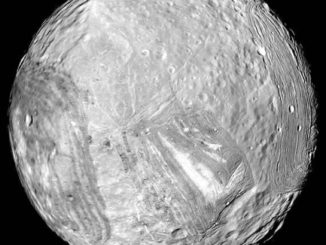
More than 41 years and nearly 18 billion kilometres (11 billion miles) from Earth, NASA’s Voyager 2 probe has finally passed beyond the protective bubble defined by the Sun’s magnetic fields and solar wind, joining its sistership Voyager 1 in the uncharted reaches of interstellar space.
The historic milestone was noted on 5 November when data streaming back from Voyager 2 indicated the probe had crossed the outer edge of the Sun’s heliosphere, moving beyond the influence of the solar wind and the Sun’s magnetic fields. The boundary marking the transition between the hot-but-tenuous solar wind and the cold interstellar medium is known as the heliopause.
“I think we’re all happy and relieved that the Voyager probes have both operated long enough to make it past this milestone,” said Suzanne Dodd, Voyager project manager at NASA’s Jet Propulsion Laboratory. “This is what we’ve all been waiting for. Now we’re looking forward to what we’ll be able to learn from having both probes outside the heliopause.”

Voyager 2’s Plasma Science Experiment, or PLS, observed a sharp decline in the speed of solar wind particles around the spacecraft on 5 November and has seen no signs of it since. Three other on-board instruments measuring cosmic rays, low-energy charged particles and magnetic fields also indicated the transition into interstellar space.
Voyager 1, launched 16 days after Voyager 2 in 1977, crossed that boundary at a different location in 2012.
“Voyager has a very special place for us in our heliophysics fleet,” said Nicola Fox, director of the Heliophysics Division at NASA Headquarters. “Our studies start at the Sun and extend out to everything the solar wind touches. To have the Voyagers sending back information about the edge of the Sun’s influence gives us an unprecedented glimpse of truly uncharted territory.”
While both Voyagers are now beyond the Sun’s electrical and magnetic influence, they have not yet left the solar system. That ultimate boundary is on the far side of the Oort Cloud, a vast swarm of debris left over from the formation of the solar system that is still under the influence of the Sun’s gravity. It is believed to begin about 1,000 astronomical units from the Sun and extend to a distance of about 100,000 AU.
At its current velocity, it will take Voyager 2 about 300 more years to reach the inner edge of the Oort Cloud and possibly 30,000 years to move past it, beyond all trace of its home solar system.



